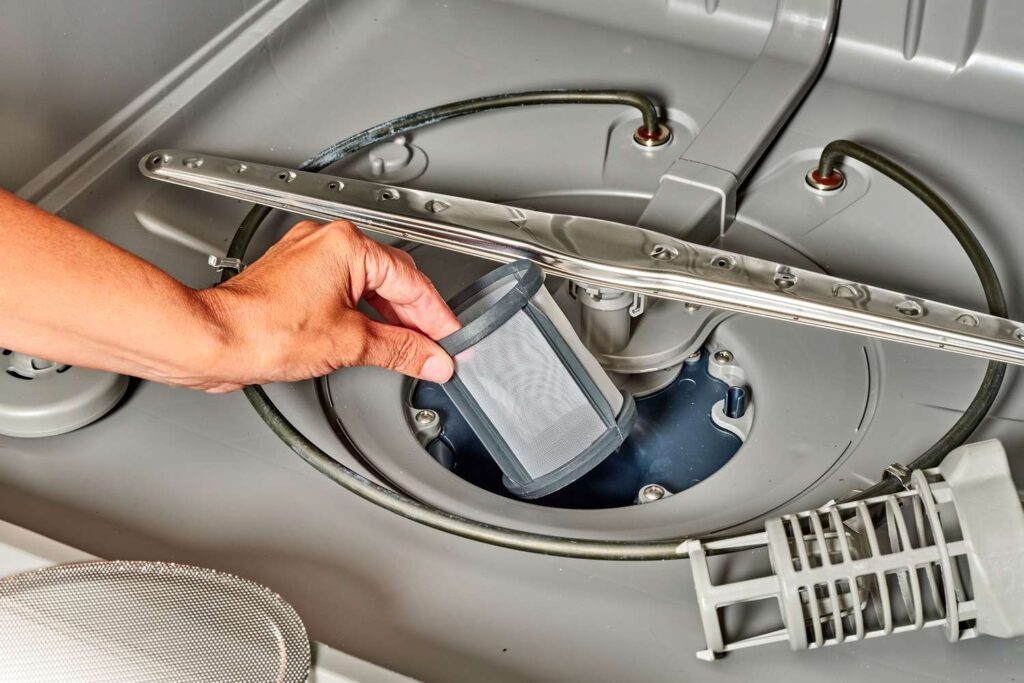Is your dishwasher full of standing water after a wash cycle? A dishwasher not draining properly is a common issue that can cause frustration, mess, and even damage. The good news is that the problem is often easy to identify and fix. In this guide, we’ll break down the most common causes, walk you through troubleshooting steps, and share expert tips to keep your dishwasher running smoothly.
Common Reasons Why a Dishwasher Won’t Drain
1. Clogged Filter
Most modern dishwashers come with a removable filter at the bottom to catch food debris. Over time, this filter can become clogged, restricting water flow.
- Symptoms: Water pooling at the bottom, strange smell.
- Solution: Remove and rinse the filter with warm water and dish soap.
2. Blocked or Kinked Drain Hose
The drain hose carries water from the dishwasher to the sink drain or garbage disposal. A kinked or clogged hose can prevent proper drainage.
- Symptoms: Gurgling sounds, water remaining in tub.
- Solution: Inspect the hose for blockages or bends. Detach and flush it if necessary.
3. Garbage Disposal Plug Not Removed
If your dishwasher was recently installed and drains into a garbage disposal, the knockout plug inside the disposal inlet might still be intact.
- Symptoms: Brand-new dishwasher not draining.
- Solution: Remove the dishwasher drain hose and punch out the knockout plug.
4. Clogged Air Gap or Drain Valve
Some setups include an air gap or a drain valve to prevent backflow. These can become blocked with debris or grease.
- Symptoms: Slow or partial draining.
- Solution: Clean the air gap (typically located on the sink) and inspect the drain valve.
5. Faulty Drain Pump
The drain pump pushes water out during the drain cycle. If it’s defective, your dishwasher won’t drain.
- Symptoms: Humming sound, no drainage at all.
- Solution: Test the pump for continuity with a multimeter. Replace if necessary.
6. Control Board or Timer Malfunction
A failed timer or electronic control board might not send the proper signal to start the drain cycle.
- Symptoms: No sound/activity during the drain cycle.
- Solution: Advanced diagnostics or replacement may be needed. Consider contacting a professional.
Step-by-Step Troubleshooting Guide
- Turn Off Power
- Always disconnect the dishwasher from power before inspecting or repairing.
- Remove Standing Water
- Use a cup or towel to soak up any remaining water in the tub.
- Inspect the Filter
- Remove the bottom rack, take out the filter, and rinse thoroughly.
- Check the Drain Hose
- Look for blockages, bends, or signs of damage. Clean with a long flexible brush if needed.
- Clean the Garbage Disposal and Air Gap
- Run the disposal and flush it with hot water. Detach and clean the air gap if applicable.
- Run a Test Cycle
- Once cleaned, run a rinse cycle to check if the dishwasher drains properly.
Preventive Tips to Avoid Drainage Problems
- Scrape plates before loading (don’t prewash — just remove large debris).
- Clean the filter weekly if you use your dishwasher daily.
- Use dishwasher-safe detergent to avoid residue buildup.
- Run hot water in the sink before starting a cycle to help dissolve grease.
- Schedule regular maintenance or DIY inspections every few months.
When to Call a Professional
If you’ve tried all the above steps and your dishwasher still doesn’t drain, it might be time to call in a certified appliance technician. Internal electrical or mechanical faults can be complex and may require specific tools or replacement parts.
Conclusion
A dishwasher not draining can be caused by something as simple as a dirty filter or as complex as a broken pump. The key is to diagnose the issue step by step and address it early to avoid bigger problems later. With a bit of effort, you can often get your appliance back in working order without needing a costly repair.

